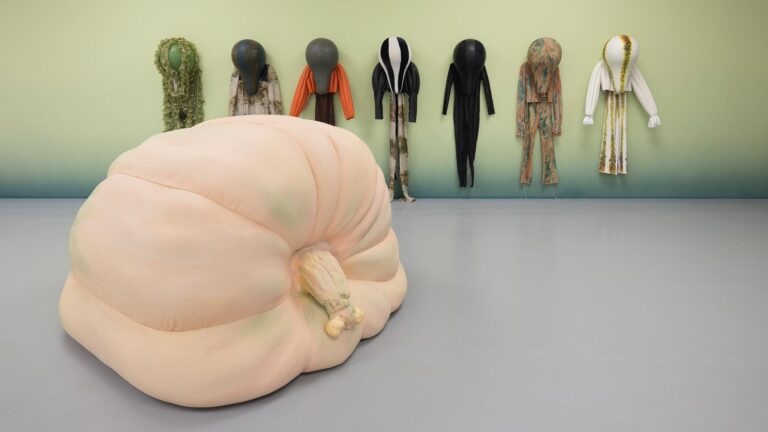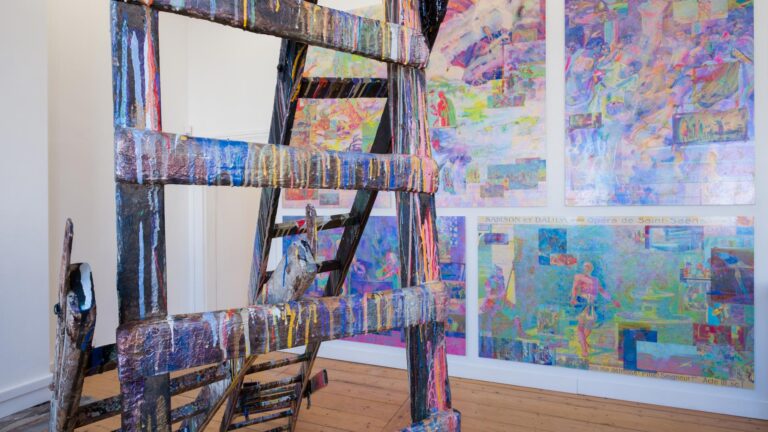Artist: Jacopo Pagin
Exhibition title: Crystal Whisper
Venue: Everyday Gallery, Antwerp, Belgium
Date: May 6 – June 12, 2021
Photography: Silvia Cappellari, Seppe Elewaut / all images copyright and courtesy of the artist and Everyday Gallery, Antwerp
In ‘Crystal Whisper’ painted glass becomes a vessel for mystical charge. Translucent objects and faint presences become breaths. Jacopo Pagin’s canvas turns into foil, in which light flares and historical references doom up from the ether. A portal to 18th century Venice, Murano glass becomes a way to embrace the entire history of art, and embody spirits.
For this exhibition, Jacopo Pagin invited artist Richard Venlet to reconfigure the gallery space. The installation of the Belgian artist becomes a hybrid between architecture and art display, a metaphysical pavilion that opens to an interior for intimacy and reflection. Jacopo Pagin in turn projected his own intervention by painting onto the walls enlarged details of his surrounding works, mirroring the exhibition’s spectral appearances.
The Show embraces through the evocation of crystal — an iconic and domestic material and object— the entire history of art, from the Renaissance to the 20th century.
Through their subtle homages and references, Jacopo Pagin’s paintings go beyond a purely historicist attitude. Far from being an artist with rigorously historical compositions, he paints as if he were working under the influence of LSD, with contrasting colors, dreamlike and mysterious themes, reminiscent of Post Punk or New Romantic album covers. He shares with that music the importance of an underlying presence; the bass for New Wave is the story for his painting. He is a painter who knows his art history, especially that of his native Veneto.
Pagin retraces history in his work, whose subjects (still lifes, landscapes, mystical scenes or portraits of objects) as well as motifs, colors or composition are inspired by the art of the Renaissance to the beginning of the 20th century. The elongation of the figures and objects, the delicate tones and the strange, haunting, slightly melancholic beauty of the compositions echo past artistic periods, such as Mannerism of the end of the 16th century, Rococo, the height of the aesthetic of the end of the Ancien Régime, or the dreamy, grandiose Neoclassicism of the 1930s. He is thus the painter of a fin de siècle aesthetic, or rather, of the end of a cycle, through his capacity for synthesis.
Although Jacopo Pagin’s painting is dreamlike and ethereal, his works should not be limited to simple pictorial musings. On the contrary, the Italian artist’s paintings are full of references to the history of art and painting. Drawing on the sources of Venetian painting from the Renaissance to the eighteenth century, Pagin plays with the recurring, almost clichéd forms and motifs of this period in the history of Venice. Venetian art emerged at the beginning of the Renaissance when the lakeside city distanced itself from the influence of its Byzantine ancestors and adopted Gothic forms and subjects, participating in the emergence of a radiant Gothic style, and a fusion of styles from the north and south of Europe, thanks to the trade between Flanders and Italy. The direct access to Flemish art had such a strong influence on the Italian painters that it changed their perception of reality, which made them bring together the conquest of space in its Tuscan form and the sense of detail of Flemish paintings.
In Pagin’s paintings, we find the power of Giorgione’s skies and the smooth, “melted” touch of Venetian painting in backgrounds covered with undulating lines and waves. We can also easily see an affinity with Veronese or Julius Romano (verticality, exaggeration, strong chromatics), particularly in Jacopo Pagin’s older works, such as La Cavalcata Dell’ignoranza (2014), where the representation of the body really echoes the works of the artist of the Palazzo del Te. The asymmetry, vaporous atmosphere and varnish of an unreal halo of Tintoretto’s The Last Supper (1592-1594) can also be found in his more recent works. The elongation of the forms and the impression of Mannerist mist certainly contribute to the dreamlike quality of Pagin’s paintings.
The contribution of the Flemings in Venice, for example with the importance of still life and the depiction of silver and glassware, is reflected in his painting a few centuries later. He perpetuates the Italian vision of Flemish painting, in an echo of the Italian collectors (especially from Venice and Naples) of Flemish Renaissance painting.
The otherworldly visions he offers the public are also out of time, and in his paintings he brings together a concentration of eighteenth-century Italy. Like Pietro Longhi or Canaletto, Pagin knows how to translate into paint the quaint strangeness of the Venetian carnival, its masks and its almost ghostly figures; the return of vases and glasses is also a tribute to the Murano factories. The influence, or shadow, of the gallant 18th century can also be found in ‘Chinese Syndrome’, a painting from 2021, which depicts three strangely anthropomorphic crystal cups (one can distinguish eyes, a hand…) against a background of wallpaper decorated with pagodas. It can also be compared to a romantic gesture, to a search for the sublime and the strange, often nostalgic.
At the end of the 18th century, the Venetian school ceased to exist, but the emergence of Romantic painting meant that the pictorial quest for atmospheric effects and blended colors, which had peaked in Venice two centuries earlier, survived. The search for grandeur, verticality, the exploration of intimacy, dreams and the unspeakable in Romanticism is also reflected in the work of Jacopo Pagin. The exploration of the intimate, of dreams and of the unspeakable in Romanticism is also found in the work of the artist. Like the Mannerist paintings that brought the High Renaissance to a close, are the Italian’s paintings the end of a period? More than the end of a period, Jacopo Pagin’s works embody a temporal synthesis of different highlights in art history. His work is like the surreal light at the end of the day. In some ways, his work should be seen in the context of the Romantic ramifications of the early 20th century, especially in the compositions that emphasize a sense of the sublime and the strange.
Jacopo Pagin’s painting is a painting of borders, shifts and margins. The aesthetic impact of his dreamy and mysterious compositions, the sometimes contrasting, sometimes soothing and voluptuous chromaticism, and the elongation of forms and figures thus recall an end-of-cycle aesthetic, without touching on a pessimistic decadence. The vitality of his paintings is a doorway to an elsewhere where elements from different periods of art history are brought together in a strong and synthetic syncretism. If the stamp of Italian painting is naturally strong in his art, he is also close to painting of the interwar period. He is reminiscent of the Surrealists; for example, his most carnivalesque compositions are reminiscent of De Chirico, Magritte and Leonor Fini. But he can also be compared to the French Prix de Rome, like Pougheon or Dupas. Little known today, these figurative painters practiced a neo-Mannerism infused with the exaggerations of Ingres in the interwar period, producing strange scenes populated with petite and translucent women, exotic birds and heterogeneous assemblages of objects and plants, in an atmosphere that was often misty or dim. Just like Matisse or De Chirico, Pagin made, beyond still lifes, real object portraits. The recurring appearance of the glass goblet, cup or vase, or the Carnival mask underlines his interest in iconic objects, which become recurring motifs and leitmotifs, which he anthropomorphizes by turning them into an eye, a hand, or a face. It is also an art that sublimates the everyday, in which he highlights everyday objects that, as with De Chirico (Un Cri d’amour, 1934), become characters. The temporal journey that he offers the viewer thus takes us from the Renaissance to the contemporary, where his vibrant colours and hallucinatory compositions embody the reminiscences of an underground and romantic culture that has been regularly resurfacing since the 18th century.
-Text by Céline Mathieu and Emmanuelle Luciani.




























